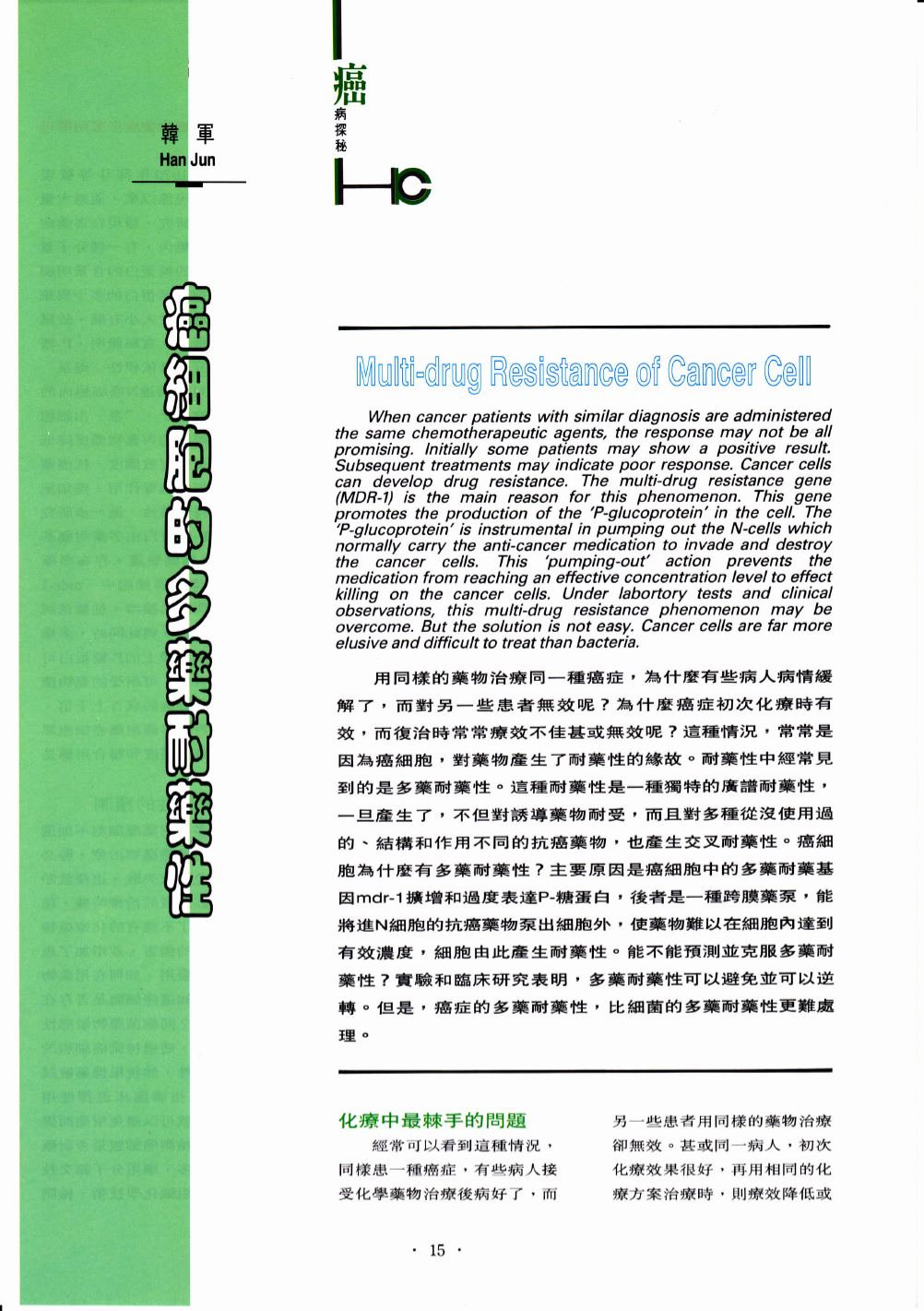
l
ffi
tttt
fi
fr
1
ii
t+
HF
Han
Jun
ffi
ffi
m
ffi
g
ffi
b-J
ffi
m
ffi
ru'g
Reslslianee
oll
Gancer
Gell
When cancer
patients with similar
diagnosis are
administered
the same chemotherapeutic agents, the response may
not be
all
promising.
lnitially
some patients
may show
a
positive
result.
Subsequent treatments may indicate
poor
response.
Cancer cells
can
develop
drug
resistance.
The multi-drug
resistance
gene
(MDR-|)
is
the
main
reason
for
this
phenomenon. This
gene
promotes the production
of
the
'P-glucoprotein'
in
the cell.
The
'P-glucoprotein'
is
instrumental
in
pumping out
the N-cells
which
normally carry
the anti-cancer medication
to
invade
and
destroy
the
caincer
cells.
This
'pumping-out'
action
prevents
the
medication from
reaching an effective
concentration
levelto
effect
killing
on
the
cancer
cells.
Under
labortory
tests
and
clinical
observations,
this multi-drug
resistance
phenomenon
may
be
overcome. But the solution
is not
easy. Cancer cells
are
far
more
elusive and
difficult
to treat than bacteria.
H trJt##]*+'J
]EffiE{-
fi€'EE'
H
T+
ffiH Wffi
Affi'FHffi
'*.,
ffi
'lF.ieE+
H
H
)H
4ft
T'f+
ElEIft
-"r|.Ffe
?
iEfi€'lEtE,'
H
H
E
tr
HTEffiEE
'
Yt#-+rr4+-Tnfi#:ls#r?&&.'
trE-f
#'Ef
4
?#H
R.
El #t
F
*
*mt
*'Et'
i€
iGE IE"f
*'Et
E
-
#€ffi
++
At
E
ig
ffif
#'El'
H!
-
ffi
+#
f
a,tE
HZi
lEl
H!
*ilrE*+rr,
rgE
+
=
gffif
*'Et
"
JEffl
ffiH
T+
EA
T
*frT*,|+
?
E
E
JF
tr
E,Effi
FE
+
#J
**iIfr*E
El
mdr-1
ffi
rEfEiEE*j€p-fEE
E'
&E"E-fi€EEH*fr
,
eE
ig
€
N
ffi
EE
#t
fn:{E**vt
fr
fr
ffi
EA
t
l,
Itr,#
44t
#t)r
A
ffi
EE
*r
r:E E|J
a
-.e.iH
E'
?#EEH
tLE
+
iff
*,Et "
e?7"-e?ffifr\fr.fr,8e-**frt
*'l+.
?
H
"qfi
f
n W"
I^nfr
fr.
t
FE,
t
*frt*'llt
FI
t:{
Eg
fr.frFl
Ly-;E
TEo
+r.ffi+
E+^+H!
F-lEF
A9'H
pI
D^E=U
Ef€jH
ifl,'
Itr
f*,H
-fE
ffi
'ft.,
E
tb3ffi
^+*
F4t4*+rrhffi1ft.ffit+T
.ffi
fl-'&HA
ffiH+##J*+rr16ffi
AFft-tft "
EEIIE-ffi^'+nW
t5


